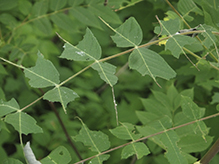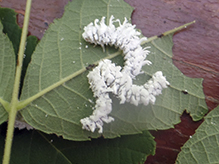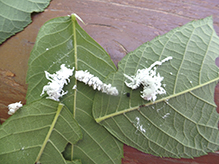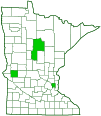Butternut woollyworm
(Eriocampa juglandis)
Conservation • Description • Habitat • Ecology • Distribution • Taxonomy
Conservation Status |
|
||||
| IUCN Red List | not listed |
||||
| NatureServe | not listed |
||||
| Minnesota | not listed |
||||
Description |
Butternut woollyworm is a common sawfly. It occurs in the United States east of the Great Plains and in southern Ontario and Quebec. It is most common in the northeast, rare in Minnesota. The larva is host-specific, feeding almost exclusively on the leaves of butternut and black walnut, though it has been collected on hickory in the northeast. Adults feed on pollen, nectar, honeydew, sap, and other insects. Females are 5 ⁄16″ (7.7 to 8.4 mm) long. Males are smaller, ¼″ (6.3 to 6.8 mm) long. The head is mostly black. The sensory organs on the upper jaw (labial palpi) and lower jaw (maxillary palpi) are brownish. The antennae are thread-like, stout, and mostly black. They have 9 segments. Segment 2 is longer than wide. Segment 3 is longer than segment 2. Segments 5 through 9 are reduced in size and are brownish on the underside. Segments 7 and 8 are not broadened at the tip. The body is robust and entirely black. The thorax and abdomen are broadly connected. The middle thoracic exoskeletal plate (mesoscutellum) is covered with deep, closely spaced punctures. The female has a saw-like ovipositor at the tip of the abdomen. The wings are mostly clear and evenly tinged brown. On the forewing, the anal crossvein is oblique. On the hindwing both the radial sector (Rs) cell and the media (M) cell are present. On the male the hindwing does not have a peripheral vein. The legs are long and slender and mostly white. The basal half of the first segment (coxa) of each leg is black. The second segment (trochanter) has two segments. On the hind leg the end third of the third segment (femur), the end third of the fourth segment (tibia), and the tip of the last section (tarsus), are black. On the front leg the tibia has two spurs at the tip. Late stage larvae are ⅝″ to 13⁄16″ (15 to 21 mm) long. The head capsule is white with two black eye spots. The body is densely covered with white, cottony or woolly, hair-like processes (flocculence). This feature gives the species its common name. The flocculence is shed with each molt. Late stage bare larvae are pale green. |
Size |
Male: ¼″ (6.3 to 6.8 mm) Female: 5⁄16″ (7.7 to 8.4 mm) |
Similar Species |
Habitat |
|
Ecology |
Season |
One generation per year in Minnesota: July and August |
Behavior |
|
Life Cycle |
|
Larva Food |
Leaves of mostly black walnut and butternut, but it has also been reported on hickory. |
Adult Food |
Pollen, nectar, honeydew, sap, and other insects. |
Distribution |
||
|
Sources |
|
| 9/23/2025 | ||
Occurrence |
||
Uncommon throughout its range, rare in Minnesota |
||
Taxonomy |
|
Order |
Hymenoptera (Ants, Bees, Wasps, and Sawflies) |
Suborder |
Symphyta (Sawflies, Horntails, and Wood Wasps) |
Superfamily |
Tenthredinoidea (Typical Sawflies) |
Family |
|
Subfamily |
Allantinae |
| Tribe | Eriocampini |
Genus |
Eriocampa |
Subordinate Taxa |
|
|
|
Synonyms |
|
Selandria caryae |
|
Common Names |
|
butternut woollyworm (larva) butternut woollyworm sawfly (adult) |
|
Glossary
Femur
On insects and arachnids, the third, largest, most robust segment of the leg, coming immediately before the tibia. On humans, the thigh bone.
Palp
Short for pedipalp. A segmented, finger-like process of an arthropod; one is attached to each maxilla and two are attached to the labium. They function as sense organs in spiders and insects, and as weapons in scorpions. Plural: palpi or palps.
Tarsus
On insects, the last two to five subdivisions of the leg, attached to the tibia; the foot. On spiders, the last segment of the leg. Plural: tarsi.
Tibia
The fourth segment of an insect leg, after the femur and before the tarsus (foot). The fifth segment of a spider leg or palp. Plural: tibiae.
Visitor Photos
Share your photo of this insect.
This button not working for you?
Simply email us at info@MinnesotaSeasons.com.
Attach one or more photos and, if you like, a caption.
Luciearl |
||
 |
 |
|
 |
||
MinnesotaSeasons.com Photos
|

Slideshows

Visitor Videos
Share your video of this insect.
This button not working for you?
Simply email us at info@MinnesotaSeasons.com.
Attach a video, a YouTube link, or a cloud storage link.
Other Videos
Butternut Wooly Worm - The Cutest Larva? Nature Now!
Nature Now! - Chris Egnoto
The bizarre Butternut Wooly Caterpillar astonishes onlookers!
onceIhadalove



